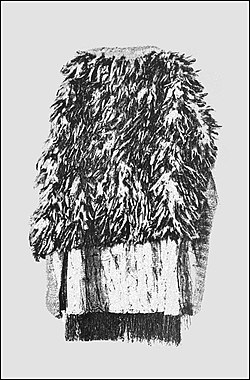copper bars as thick as the finger were in the cavity. His body was smeared, with powdered camwood. His garment of a large piece of fig bark, stained with camwood, reached in graceful folds down the body. Round thongs of buffalo hide, with heavy copper balls at the ends, hung around his waist in a huge knot and, like a girdle, held the coat, which was neatly hemmed. Around the neck hung a copper ornament with little points radiating like beams over the chest; on his bare arms were pendants, in shape like drumsticks, with rings at the end. Half-way up the lower arms and below the knees were three bright, horny-looking circlets of hippopotamus-hide, tipped with copper. In his right hand was a sickle-shaped scimiter of pure copper.
A piece of suitable material for a garment having been secured,  Fig. 10.—Feather Cape and Matting Blanket. New Zealand. the forms would be easily developed. We have already suggested that the close-fitting garments of the northern type of dress arose from the tying on of skins. The present forms of the southern type are almost as simple in their origin. Tylor has suggested a development of forms from the simple blanket or skin robe. The use of the blanket itself we see among many of our Indian tribes today. It is simply thrown over the shoulders, grasped at the sides by the hands, and drawn about the body. If the arms are extended while one wears a blanket in this way, the garment drapes in such a manner as to suggest sleeves. Among some tribes of the Southwest there is a slit made in the center of
Fig. 10.—Feather Cape and Matting Blanket. New Zealand. the forms would be easily developed. We have already suggested that the close-fitting garments of the northern type of dress arose from the tying on of skins. The present forms of the southern type are almost as simple in their origin. Tylor has suggested a development of forms from the simple blanket or skin robe. The use of the blanket itself we see among many of our Indian tribes today. It is simply thrown over the shoulders, grasped at the sides by the hands, and drawn about the body. If the arms are extended while one wears a blanket in this way, the garment drapes in such a manner as to suggest sleeves. Among some tribes of the Southwest there is a slit made in the center of
the blanket and the head is put through this. Such a slit blanket would easily become a loose-sleeved garment, like the one so commonly in use in Guatemala and elsewhere. The Sacs and Foxes in Iowa usually wear the blanket. If a man wishes free use of his hands for work, he folds the blanket through the middle to reduce its length, and wraps it tightly about his waist, tucking the free end tightly in. It thus becomes a skirt, and though skirts usually have not developed in this way, they may have done so sometimes. However a skirt arises, the convenience of a divided skirt sometimes suggests itself, and a pair of loose and flowing trousers re-

